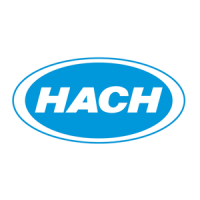Maintenance
40
b. Allow to stand for no more than four hours (more standing time can deplete
the reference solution and damage the glass bulb).
c. Retest.
5. If neither of the above methods are successful, the sensor must be replaced.
5.4.2.1 Drifting test results
A film on the pH sensor bulb or the reference can cause drifting. Use isopropyl
alcohol to clean the glass bulb.
Note: The sensor bulb is very thin and delicate. Do not scrub the pH/ORP sensor.
To clean the sensor:
1. Use isopropyl alcohol or a foaming, non-abrasive household cleaner. Hach
acid electrode cleaning solution may also be used less frequently.
2. Pour any of these solutions in the cell cup and allow it to soak for no more than
five minutes.
3. Use a cotton swab to gently clean the electrodes.
4. Rinse out the cleaning solution.
5. Fill the sensor cup with Hach pH storage solution before the pH/ORP sensor
cap is replaced.
5.4.2.2 Solutions that damage the pH/ORP sensor
Samples that contain chlorine, sulfur or ammonia can damage the pH electrode.
Rinse the sensor thoroughly with clean water immediately after any measurement
of these liquids.
Samples that reduce (add an electron to) silver, such as cyanide will attack the
reference electrode.
Leaving alkaline solutions in the pH sensor cup for long periods of time can
damage the sensor.

